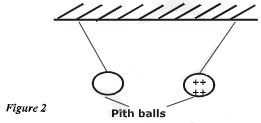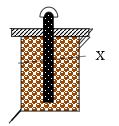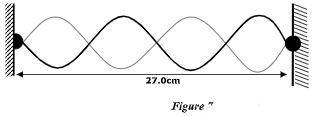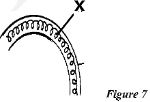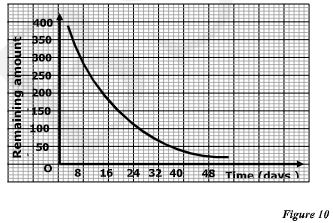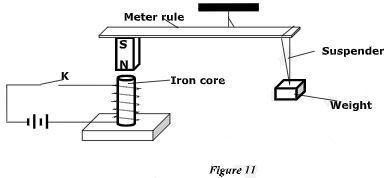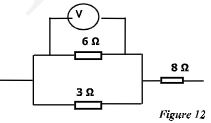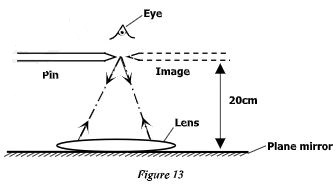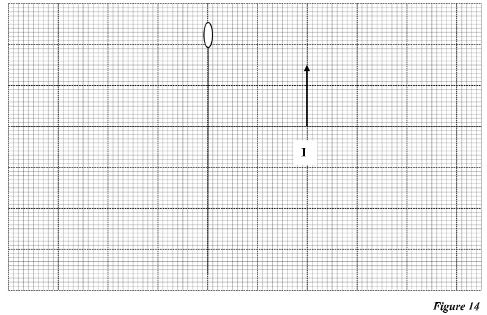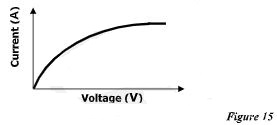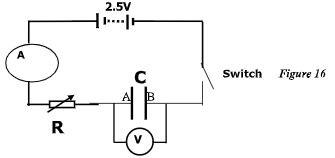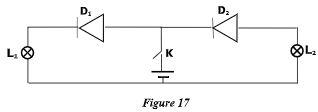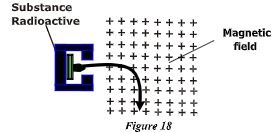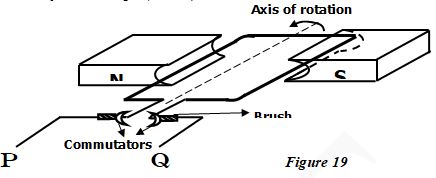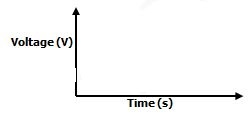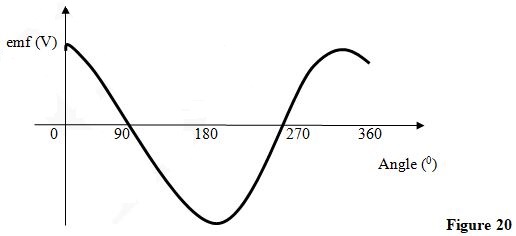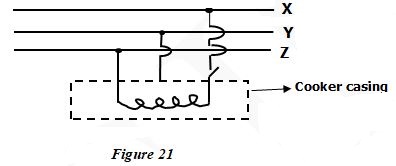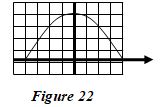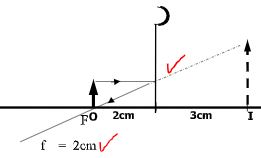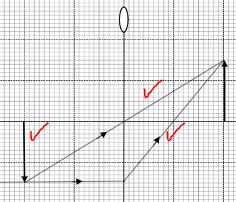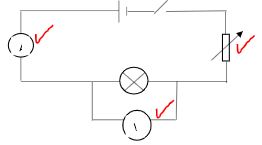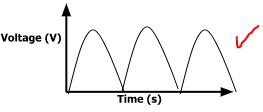Questions
Instructions to Candidates
- This paper consists of two sections; A and B
- Answer all the questions in section A and B in the spaces provided
- All workings must be clearly shown in the spaces provided below each question
- Non programmable silent electronic calculators may be used.
- Candidates should answer the questions in English
SECTION A (25marks)
Answer all the questions in this section in the spaces provided
- Figure 1 below shows a plan view of an object O in front of a plane mirror
Which one of the reflected rays of light P, Q, R and S appears to come from the image of O (1 mark) - Figure 2 below shows an uncharged pith ball A under the attraction of a charged ball B.
State and explain what would be observed after the two pith ball touch each other (2 marks) - Figure 3 below shows the features of a dry Leclanche cell.
State the function of the part labelled X (1 mark) - What is meant by the term “lost volts” as used in cells (1 mark)
- Figure 4 below shows a longitudinal wave that takes 0.5s to move from point A to B and at a speed of 36m/s.
Calculate the frequency of the wave (2 marks) - Figure 5 represents an object O and the image I formed by a concave mirror.
By suitable rays, determine the focal length of the mirror. (2 marks) - Figure 6 shows white light falling on a prism as indicated.
- Name the colour at X and Y (2 marks)
- What measurable quantity is associated with colour of light? (1 mark)
- Explain how hammering demagnetizes a magnetized iron bar (2 marks)
- Figure 7 shows a standing wave on a string, fixed at both ends.
Explain how the standing wave is generated. (3 marks) - Figure 8 below shows a positive charge near a plate carrying negative charge.
Draw the electric field between them. (2 marks) - Figure 9 represents part of electric cooker coil.
- Why is the material labeled X is coiled? (1 mark)
- State the property of material X that makes it suitable for its use. (1 mark)
- State two factors affecting the type of shadow formed by an object placed in front of a source of light. (2 marks)
- The graph below shows radioactive decay of iodine.
Use the graph to determine the fraction of the amount remaining after 16 days. (2 marks)
SECTION B (55 marks)
Answer all the questions in this section in the spaces provided
-
- In the setup below, the suspended meter rule is in equilibrium balanced by the magnet and the weight shown. The iron core is fixed to the bench.
- State and explain the effect on the meter rule when the switch K is closed. (3 marks)
- What would be the effect of reversing the battery terminals? (1 mark)
- Figure 12 shows three resistors connected as shown.
If the voltmeter, V reads 4V, find the Potential difference across the 8Ω resistor. (3marks) - A student stands some distance from a high wall and claps her hands.
- What two measurements would he need to make in order to determine the speed of sound? (2 marks)
- Show how you would make use of these measurements to determine the speed of sound in air (1 mark)
- In the setup below, the suspended meter rule is in equilibrium balanced by the magnet and the weight shown. The iron core is fixed to the bench.
-
- Students wanted to determine the focal length of a convex lens of thickness 0.6cm using an optical pin and a plane mirror. Figure 13 shows the experimental set up used when there was no parallax between the pin and the image.
- Use the setup to determine the focal length of the lens. (2 marks)
- Explain how you arrive at your answer. (2 marks)
- An Image, I 15cm tall stands vertically on the principal axis of a convex lens of focal length 10cm and at a distance of 20cm from the lens as shown in figure 14 below.
(the graph is drawn to scale)- By ray construction, complete the diagram to show the position of the object (3 marks)
- Determine the size of the object (1 mark)
- Determine the object distance (1 mark)
- Students wanted to determine the focal length of a convex lens of thickness 0.6cm using an optical pin and a plane mirror. Figure 13 shows the experimental set up used when there was no parallax between the pin and the image.
-
- For a particular bulb, a series of readings of the current through the bulb for different potential differences across it is taken and plotted as shown in figure 15 below.
- Draw the circuit diagram you would use for the experiment. (3 marks)
- Explain how the resistance of the bulb changes (1 mark)
- The figure 16 below shows a capacitor C being charged.
- State what would be observed on the ammeter when the switch is closed: (1 mark)
- Explain how the capacitor is charged. (3 marks)
- For a particular bulb, a series of readings of the current through the bulb for different potential differences across it is taken and plotted as shown in figure 15 below.
-
- What is meant by donor impurity in a semiconductor? (1 mark)
-
- State the observation made on L 1 and L 2 when switch K is closed. (1 mark)
- Account for the observation made above. (1 mark)
- You are provided with a diode, a resistor R, an a.c source of low voltage and connecting wires. In the space provided, sketch the circuit diagram for a half-wave rectifier and indicate the terminals where the output voltage v 0 may be connected. (2 marks)
-
- Alpha particles (µ) are more ionizing than Beta (b) particles. Give two reasons for this. (2 marks)
- Fig shows the path of radiation from a radioactive source after entering a magnetic field.
The magnetic field is directed into the paper and is perpendicular to the place of the paper shown in the figure.- Identify the radiation. (1 mark)
- Give a reason for your answer. (1 mark)
- What is meant by donor impurity in a semiconductor? (1 mark)
-
- A surface whose work function is 2.46eV is illuminated by light of frequency 3x10 15 Hz. Calculate the maximum kinetic energy of the ejected photoelectrons.
( h = 6.63 x 10 -34 js and e = 1.6 x 10 -19 C). (3 marks) - A monochromatic beam of radiation is directed on a clean metal surface so as to produce photoelectrons. Give a reason why some of the ejected photoelectrons have more kinetic energy than others. (1 mark)
-
- Figure below shows an electric generator. The points P and Q are connected to a cathode Ray oscilloscope (C.R.O)
Sketch on the Axis provided the graph of the voltage output as seen on the C.R.O, given that when t= o, the coil is at the position shown in the figure (1 mark) - The emf generated by a.c generator is represented in the graph in Figure 20.
Give reasons for the changes in the emf as the coil rotates from 0 0 to 90 0 and 90 0 to 180 0 . (3 marks)- An immersion heater rated 3000W is used continuously for 45 minutes per day.
Calculate the cost per week at 60cts per unit. (2 marks)
- An immersion heater rated 3000W is used continuously for 45 minutes per day.
- Figure below shows an electric generator. The points P and Q are connected to a cathode Ray oscilloscope (C.R.O)
- A surface whose work function is 2.46eV is illuminated by light of frequency 3x10 15 Hz. Calculate the maximum kinetic energy of the ejected photoelectrons.
-
- Figure 21 shows the electric wiring of an electric cooker. X, Y and Z are main wires.
Identify the wires Y and X (2 marks) - What adjustment on the x-ray tube will;
- Increase the hardness of the x-rays (1 mark)
- Reduce the intensity of the x-rays. (1 mark)
- Increase the hardness of the x-rays (1 mark)
- A CRO screen with 1cm squares displays the trace in figure 22 below.
The Y- gain is set 0.5v/cm and the time base is set at 5ms/cm. Determine- the voltage (1 mark)
- the frequency of the signal (3 marks)
- Figure 23 shows as simple form of cathode ray tube, which produces a sharp shadow of a Maltese cross on a screen.
What property of cathode rays does the figure 23 above illustrate (1 mark)
- Figure 21 shows the electric wiring of an electric cooker. X, Y and Z are main wires.
Marking Scheme
- R
- The balls will repel
B will share its net charge with A hence like charges repel - It acts as a depolarizer / to help stop gas forming
- It is the potential drop in a cell due to internal resistance of the cell
- T = 0.5/2.5 = 0.2s
⸫ f = 1/T = 1/0.2 = 5Hz -
the reflected ray passing thro’ F at O -
- X – Red
Y – Violet - Wavelength
- X – Red
-
– Hammering disturbs/ loosens the dipoles
- Hence losing their orientation - - waves produced are reflected at the fixed points
- Incident and reflected waves interfere constructively at the antinodes
- And destructively at the nodes -
-
- - coiling increases the length hence resistance to increase the heating effect of electric current.
- – high melting point
- – size of the object
- Distance between the source of light and the object - – Amount remaining after 16 days = 190g
⸫ Fraction remaining after 16 days = 190/400 = 19/40 -
-
- –the meter rule tilts to the side with the magnet
- the iron core is electrically magnetized with the end near the magnet acquiring S-pole
- hence attracts the magnet and metre rule downwards - – the end of the iron core near the magnet acquires N-pole and repels the magnet making the metre rule to tilt to the side of the suspended weight.
- –the meter rule tilts to the side with the magnet
- – current through 6Ω resistor = V/R = 4/6 = 0.6667A
- current through 3Ω resistor = V/R = 4/3 = 1.3333A
⸫ Total current through 8Ω = 0.6667 + 1.3333 = 2A
Voltage across 8Ω = IR = 2 x 8 = 16V
OR
RParallel = 6 x 36 + 3 = 189 = 2 Ω
Current flowing in the circuit = V/R = 4/2 = 2A
Voltage across 8Ω = IR = 2 x 8 = 16V -
- –distance between the student and the wall
- time taken for the echo to come back to him - Speed of sound is calculated as V = 2 x distance between student and wall
time taken for the echo to come back
- –distance between the student and the wall
-
-
-
- f = 20 + 0.62 = 10.3cm
- - Rays from the object pass through the lens and are refracted parallel to the principal axis
- The parallel rays are then reflected back by the mirror to the lens which converge them to a point that coincides with the object.
-
-
- -ho = 15cm
- v = 20cm
-
-
-
-
-
The circuit diagram must be Workable - Resistance increases with increase in temperature
-
-
- the ammeter reading reduces from maximum to zero
-
- electrons move from negative terminal of the cell to B
- at the same time electrons move from plate A to the positive terminal of the Cell
- equal amounts of positive and negative charges are stored in plate A and B respectively
-
-
- Is the pentavalent atoms that donates free electrons to a semiconductor during Doping.
-
- - L1 lights while L2 does not
- -when the switch is closed D1 is forward biased while D2 is reverse biased
-
- Alpha is more massive hence collides with more air molecules
- Alpha is slow moving in air hence takes more time in air
-
- Beta particle
- because of motor- effect / Flemings Left Hand Rule
-
-
-
- hf = θ + eV
6.63 x 10-34 x 3.0 x 108 = 1.6 x 10-19 x 2.46 + K.E
K. E = 1.989 x 10-18 - 3.936 x 10-19
K. E = 1.5954 x 10-19 J - due to varying photon energies / different photons have different energies
-
-
at least 2 crests -
- from 0ᵒ - 90ᵒ magnetic flux linkage changes from high to low/decreasing
- From 90ᵒ - 180ᵒ magnetic flux changes from low to high/increasing
- At 0ᵒ and 180ᵒ magnetic flux change is maximum though in different directions
-
- Cost = Kwh x unit cost = 3 x 45/60 x 7 x .60 = ksh 9.45
- hf = θ + eV
-
-
- X – Live wire
- Y - Earth wire
-
- increasing the accelerating voltage / potential difference between cathode and anode
- Reducing the filament / cathode current
-
- Voltage = 4cm x 0.5V/cm = 2V
- 1/2 T = 8cm 5ms/cm = 40ms
⸫ T = 40ms x 2 = 80ms = 0.08s
f = 1/T = 1/0.08 = 12.5Hz
- cathode rays travels in straight lines
-
Download Physics Paper 2 Questions and Answers - Bondo Joint Mocks Exams 2022.
Tap Here to Download for 50/-
Get on WhatsApp for 50/-
Why download?
- ✔ To read offline at any time.
- ✔ To Print at your convenience
- ✔ Share Easily with Friends / Students


